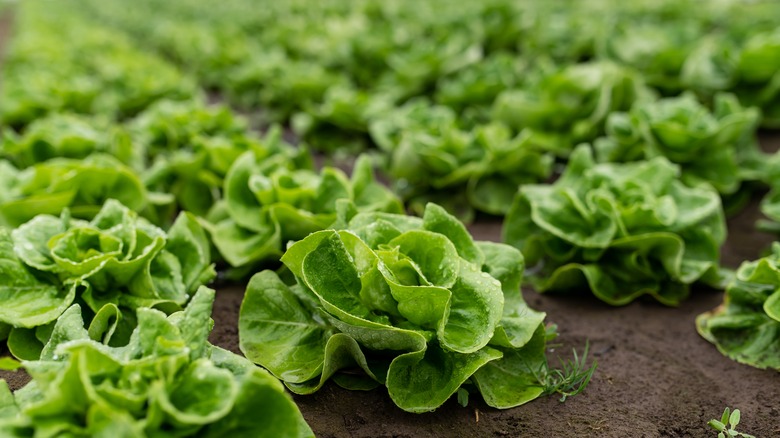How The Current Lettuce Shortage Is Affecting Restaurants Across The US
Food shortages are an unfortunately common occurrence these days for many consumers. Parade lists several of the shortages that were projected for 2022, which touch on a number of food categories. Shortfalls are expected to impact plant-based proteins, poultry, beef, eggs, dairy products, and numerous canned goods. Reasons for these current shortages run the gamut, such as lingering effects from the pandemic, the ongoing war in Ukraine, the impact of climate change, and a lack of workers — just to name a few.
Assorted types of produce are also on the chopping block it seems. For instance, a current lettuce shortage has consumers all over the country reeling at the soaring prices they're seeing in grocery stores. The Produce News described current prices as "extremely high," and projected that prices will continue to rise thanks to dwindling supplies and consistent demand.
Many of America's favorite restaurants are also feeling the crunch when it comes to lettuce shortages.
Restaurants are warning customers about possible changes to their menu
Lettuce is a common ingredient in so many food preparations it's hard to count them all. It lays the foundation for delicious salads and tops juicy burgers. It's a common taco topping in the U.S. and can also be found on many gourmet sandwiches. Accordingly, a dearth of lettuce can potentially affect numerous menu items at virtually every restaurant and dining establishment.
As a result, many famous establishments are taking a proactive approach to get in front of the issue. As reported by Insider, many chains are presenting warnings to customers to make them aware of the shortage. Subway is issuing alerts regarding the temporary unavailability of lettuce at their locations. Customers using the Chick-fil-A app are seeing a message claiming a possibility of menu alterations or unavailability due to supply chain issues involving lettuce. Taco Bell also posted a message on their app regarding potential shortages and their effect on menu items.
While other recent food shortages are thought to have several causes, the current lettuce scarcity can be blamed on disease.
Two diseases are at the heart of the current shortage
According to the California Farm Bureau's AgAlert, the Salinas Valley has a huge responsibility when it comes to leafy greens. Aptly nicknamed the "Salad Bowl," this area accounts for over half of the lettuce yield in America, with typical yearly sales figures of $1.2 billion. The primary issue affecting recent crops is impatiens necrotic spot virus (INSV), which is spread by insects called thrips. Prolific thrips can easily hop from plant to plant, which means their spread of INSV is equally prolific. Once infected, plants will cease growing and develop lesions. Thrips have posed similar problems in the past and it's believed that unseasonably warm winters are allowing them to do even more damage.
Lettuce infected with INSV can also fall victim to other diseases. As explained by the Western Farm Press, lettuce crops in the Salinas Valley are additionally experiencing Pythium wilt due to the impact of INSV. Once INSV takes hold, it weakens the plant's defenses against pathogens in the soil, which is what causes Pythium wilt. In response to the issues within the Salinas Valley, growers in Arizona and other parts of California planted their crops early in the hopes that an early harvest will offset the effects of this shortage.


